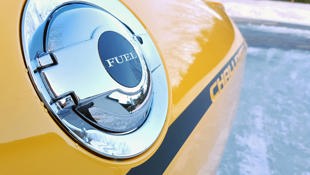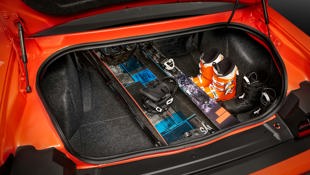Update (April 24, 2017): An earlier version of this article stated that an updated Uconnect interface with Android Auto and Apple CarPlay was standard on the Challenger GT. This is true of the American market; however, it is a $700 option here in Canada.
Does a car still qualify as American muscle if it comes with all-wheel drive?
But what if you could have power to the front wheels when you need it and rear-wheel skidding when you want it?
Heck yeah, it does.
Dodge is calling the 2017 Dodge Challenger GT the first and only all-wheel-drive American muscle coupe, and the idea may have some purists up in arms. If you can’t swing the rear end out then it’s not a muscle car, right?
But what if you could have power to the front wheels when you need it and rear-wheel skidding when you want it?
That’s what Dodge has pulled off here, and it’s brilliant. Not perfect, but brilliant.
The system is adapted from the Challenger’s bigger and longer-wheelbase brother, the Dodge Charger, which has an active transfer case that can fully disconnect the front axle in better driving conditions. Plus, 19-inch wheels are added along with another special treat: the suspension is the ultra-stiff one used in the Charger Pursuit police car, meaning this configuration is currently the only way to get it with two doors.
For the most part, it rides remarkably well. It does get crashy on very rough roads, but such is the price paid for great handling. (That said, I’m not sure I’d want to put a carsick-prone kid in the back on the regular. Mine has a stomach of steel, so I’m golden. Your mileage may vary.)
From there the electronics kick in and crunch numbers from multiple variables to determine which axles you’re likely to want in use at a given moment. Temperature is one of the primary factors; below a certain point the system locks in all-wheel drive by default.
Dodge’s engineers declined to say where exactly that point is, but on a full day of testing on New England roads where the temperature reached a peak of 4C the system never disengaged once. I’d hazard a guess that it’s probably at about the same point where you’d typically want to switch to winter tires, that being 7C, but that really is only a guess. If you bought one and kept an eye on the graphic in the instrument cluster, it wouldn’t take you long to figure it out.
There are plenty of other factors that come into play as well, such as wheel speed sensors, throttle input, steering angle, and drive mode – turning on sport mode puts you in AWD right away, for instance.
Once you’re there, the system can throw 100% bias to the rear or the front tires – though even with zero power being sent rearward, a maximum of 38% of the Pentastar V6 engine’s 268 lb-ft. of torque can go to the fronts, which adds up to just under 102 lb-ft. – and it’s calibrated to heavily favour the back wheels in situations where you’d want that, like an aggressive overtake on a straight highway.
Where I found the system really shone was in the snow autocross test. On the first lap I set everything to normal and the car behaved exactly like most all-wheel drive cars do in winter conditions: understeering, planted, and easy to control. But flip it to sport and turn the electronic stability control off – easy to do with a five-second hold of the button – and you’re throwing the back end out, carving up snow and quickly gathering it all back up for the next curve. It’s great fun.
This test also provided a preview of the next generation of FCA’s Uconnect infotainment system. That’s not specific to the Challenger GT: it will start making its way across the company’s line-up in the coming months. The old system was already one of the better ones out there, and the new version keeps the best of it while filling in the gaps: Apple CarPlay and Android Auto are now integrated, the screen’s resolution is better and graphics are sharper, and the maps are clearer and easier to read. (Bodies of water even have a realistic-looking glisten to them. Talk about attention to detail.) Most of the climate and performance settings can still only be accessed through the screen, though, so bear that in mind if you’re among the folks driven crazy by touch-heavy systems. The 8.4" Uconnect screen is standard across the board, while the updated look and Android/Apple integrations are a $700 option on Canadian Challenger GT models.
Now for the not-quite-perfect part.
All of these extra bits and bobs add a little under 90 kilograms (200 pounds) to the car’s overall weight as compared to the standard V6, and that makes a noticeable difference to how well this already-heavy car pulls in a straight line. It’s not unbearable but you’re not going to be winning any quarter-miles with it, and with all-wheel drive this is currently the only engine option.
The eight-speed automatic transmission is the same one used across the Challenger line-up. It shifts nicely on its own in normal and sport modes, but I find its reaction to my paddle shifts to be a little slower than I would like.
And if you go looking for opinions far and wide on this car you might see the Americans talking about a GT Interior Package that’s exclusive to this model. It makes the premium Nappa leather and Alcantara performance seats available with the V6 for the first time and also adds a performance steering wheel with perforated leather and an Alpine nine-speaker, 506-watt sound system. We will be getting that in Canada eventually, but it’s not available to us at launch this spring. Those seats are a dream, though – some of the most comfortable I’ve ever sat in – so it’s worth holding out for if you have the money and the patience.
I’ve said since the day I first drove one that the Challenger Hellcat is my lottery car, the one I’d buy just to play around with a few times a year if I had money to burn. Now, Dodge has made a version of the Challenger that at a base MSRP of $38,545 is affordable enough to realistically drop the coin for and practical enough to use all year round.
But if the rumours are true and Dodge really is planning an all-wheel-drive version of the Challenger Hellcat?
Lord, have mercy.
| Engine Displacement | 3.6L |
|---|---|
| Engine Cylinders | 6 |
| Peak Horsepower | 305 hp @ 6,350 rpm |
| Peak Torque | 268 lb-ft @ 4,800 rpm |
| Fuel Economy | 12.8/8.7 L/100 km city/hwy |
| Cargo Space | 458 L |






































